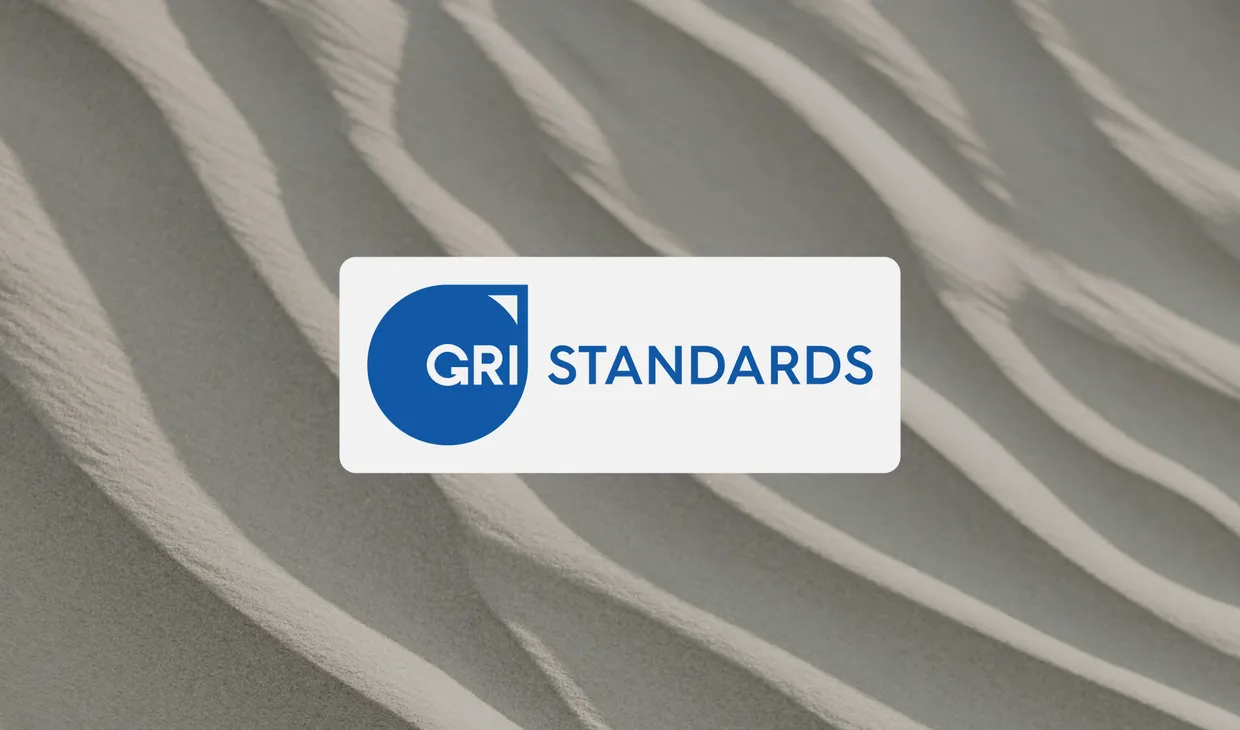What are GRI Standards and what do they include?
The GRI Standards are a modular set of reporting standards that enable organizations to disclose their sustainability impacts in a credible, comparable, and globally consistent way.
The GRI reporting process is structured around three components:
Universal Standards
The GRI Universal Standards are the foundational framework for sustainability reporting, outlining key areas such as strategy, governance, and materiality. These apply to all organizations:
- GRI 1: Foundation – introduces principles and requirements for using GRI Standards
- GRI 2: General Disclosures – covers the organization’s structure, governance, strategy, and policies
- GRI 3: Material Topics – helps organizations identify and manage their most significant impacts
Topic-specific Standards
These include detailed reporting disclosures for environmental, social, and economic topics:
- Environmental: GRI 302 (Energy) – including energy consumption and its role in sustainability reporting, GRI 305 (Emissions), GRI 306 (Waste) – with a focus on reporting significant waste related impacts such as waste generation and diversion. After listing these standards, it is important to note the role of supplier environmental assessment and the use of environmental criteria in evaluating suppliers to manage environmental risks within the supply chain.
- Social: GRI 401 (Employment) – labor practices are a key material topic, GRI 403 (Occupational health & safety) – occupational health and safety is a core component of this standard, GRI 406 (Non-discrimination), GRI 408 (Child labor), GRI 411 (Rights of Indigenous Peoples), and other human rights topics
- Economic: GRI 201 (Economic performance), GRI 205 (Anti-corruption), GRI 207 (Tax)
GRI Sector Standards
GRI sector standards offer industry-specific guidance tailored for specific sectors such as oil and gas, mining, and banking. These standards help companies with impact management by identifying sector-specific material topics and expectations, ensuring that disclosures address the most significant impacts relevant to each industry. They help companies report sector-relevant issues and align disclosures with real-world expectations. A robust materiality assessment is essential when applying sector standards, as it ensures that the most relevant sustainability topics are prioritized and reported.
How does GRI compare to US and global frameworks?
The GRI Standards emphasize impact over investor materiality, addressing a wide range of sustainability issues, including environmental, social, and governance topics. This distinguishes them from several prominent US and global ESG frameworks:
| Framework |
Focus |
Audience |
Integration with GRI |
| SASB (now part of ISSB) |
Financial materiality |
Investors |
Often used alongside GRI to align with capital markets |
| TCFD |
Climate risk and governance |
Investors and regulators |
GRI has aligned its climate disclosures with TCFD |
| ISSB (IFRS S1/S2) |
Sustainability-related financial information |
Investors and capital markets |
GRI is complementary, focusing on broader stakeholder impacts |
| CDP |
Carbon and environmental disclosures |
Global investors |
CDP aligns well with GRI 305 and environmental disclosures |
| California SB 253 & 261 |
Scope 1–3 emissions and climate risk |
Companies doing business in California |
GRI’s emissions and risk standards support compliance |
| New York’s Climate Act |
Emissions, just transition, equity |
State-regulated companies |
GRI human rights and governance disclosures help address this |
| SEC Climate Rule |
Scope 1 and 2 emissions, climate-related risks |
Public companies |
GRI helps provide deeper context and disclosure rigor |
GRI Standards are increasingly referenced in ESRS reporting, helping companies align with European sustainability regulations.
By providing a comprehensive framework for reporting on sustainability issues, the GRI Standards support sustainable development by encouraging organizations to assess and disclose their environmental, social, and governance impacts.
What should US companies include in a GRI report?
A sustainability report should follow a logical sequence, serving as the formal document organizations use to communicate their ESG performance. It should cover both required disclosures and those most relevant to the organization’s material topics, while emphasizing the importance of collecting relevant data for transparency and accuracy. The inclusion of mandatory disclosures as part of the GRI reporting process is essential for ensuring compliance and stakeholder trust.
- Materiality process: Conduct a materiality assessment to identify and prioritize sustainability topics that are most relevant to stakeholders and organizational impacts.
- Stakeholder engagement: Involve key stakeholders to ensure their concerns and expectations are addressed.
- Data collection: Gather and integrate relevant data to support accurate and complete reporting.
- Disclosure: Present information in line with GRI Standards, including all mandatory disclosures.
At the end of the report, include a GRI index to enhance transparency and traceability, helping stakeholders easily navigate the sustainability report and understand which GRI Standards and disclosures are covered.
1. Organizational profile and governance
- Company structure and activities (GRI 2)
- Governance structure and ESG oversight (GRI 2-9 to 2-16)
- Strategy and risk management approach (GRI 2-22 to 2-25)
2. Material topics and stakeholder engagement
- Stakeholder identification and engagement (GRI 2-29 to 2-30)
- Materiality process using GRI 3
- List of material topics, including environmental, social, human rights, and economic impacts
Report quantitative and qualitative information under relevant GRI topics, including:
- Environmental: energy use, emissions, water use, waste generation, biodiversity, significant risk in the supply chain and the importance of supplier assessments
- Social: labor conditions, human rights practices, customer data privacy and security, DEI, development programs that promote local community engagement, training and development, employee skills and upgrading employee skills through training programs and transition assistance programs, local communities and local community engagement initiatives
- Economic: direct economic value generated, indirect economic impacts, anti-corruption measures, tax strategy, procurement practices and supply chain management
Disclosures should be aligned with the latest versions of the GRI topic standards. Sector-specific companies should also use applicable GRI Sector Standards.
How can GRI reporting support compliance in the US?
While GRI reporting is not yet mandated in the US, it supports compliance with many existing and upcoming frameworks:
- California SB 253 & 261: GRI 305 (Emissions) and GRI 2/3 help meet emissions and climate risk reporting requirements, including climate change considerations in compliance.
- ISSB/IFRS S2: GRI provides broader disclosures on societal and environmental impacts that complement financial reporting.
- Federal Supplier Climate Risks and Resilience Rule: GRI-aligned emissions reporting can help meet these evolving requirements.
In some jurisdictions, GRI is a mandatory or recommended framework for standardized sustainability reporting, such as under the EU Non-Financial Reporting Directive.
Proactively adopting the GRI reporting system positions companies to meet emerging regulatory demands with minimal disruption.
Platforms like Sweep offer the flexibility and tools needed to manage the complexity of the GRI reporting process and improve sustainability performance through structured reporting:
- Centralized data collection: Pull in environmental and social data from across systems
- GRI-aligned templates: Ensure your reporting meets Universal and Topic-specific Standards
- Traceable methodology: Maintain audit trails for every disclosure
- Supplier engagement tools: Empower suppliers to input primary data, critical for emissions (GRI 305), labor (GRI 401), and human rights (GRI 412) disclosures
- Scenario modeling: Test different decarbonization strategies and see their impact on your material topics
Using software helps reduce manual effort, ensures consistency, and supports continuous improvement year-over-year.
What benefits can GRI reporting unlock for US businesses?
Companies that invest in high-quality GRI reporting can unlock real strategic advantages:
- Investor confidence: Strong ESG performance tied to clear disclosures attracts long-term capital
- Reputation: Transparent sustainability communications foster brand trust
- Operational efficiency: Identifying environmental and social risks early reduces disruption
- Regulatory alignment: GRI prepares companies for global and state-level disclosure requirements
- Employee engagement: Employees—especially younger generations—value employers that walk the talk
A 2024 KPMG study found that firms with advanced sustainability reporting—including GRI—are 1.3x more likely to be ranked as “high-performing” on ESG by investors.
Additionally, GRI reporting plays a key role in supporting the transition to environmentally responsible economies by encouraging organizations to assess, disclose, and improve their environmental impacts.
Final thoughts
As ESG reporting becomes a business necessity, the GRI Standards offer US companies a clear, actionable path to credible and comprehensive sustainability disclosure. Whether you’re responding to regulation, aiming to meet investor expectations, or strengthening your license to operate, adopting the GRI reporting system helps you move from compliance to leadership.



